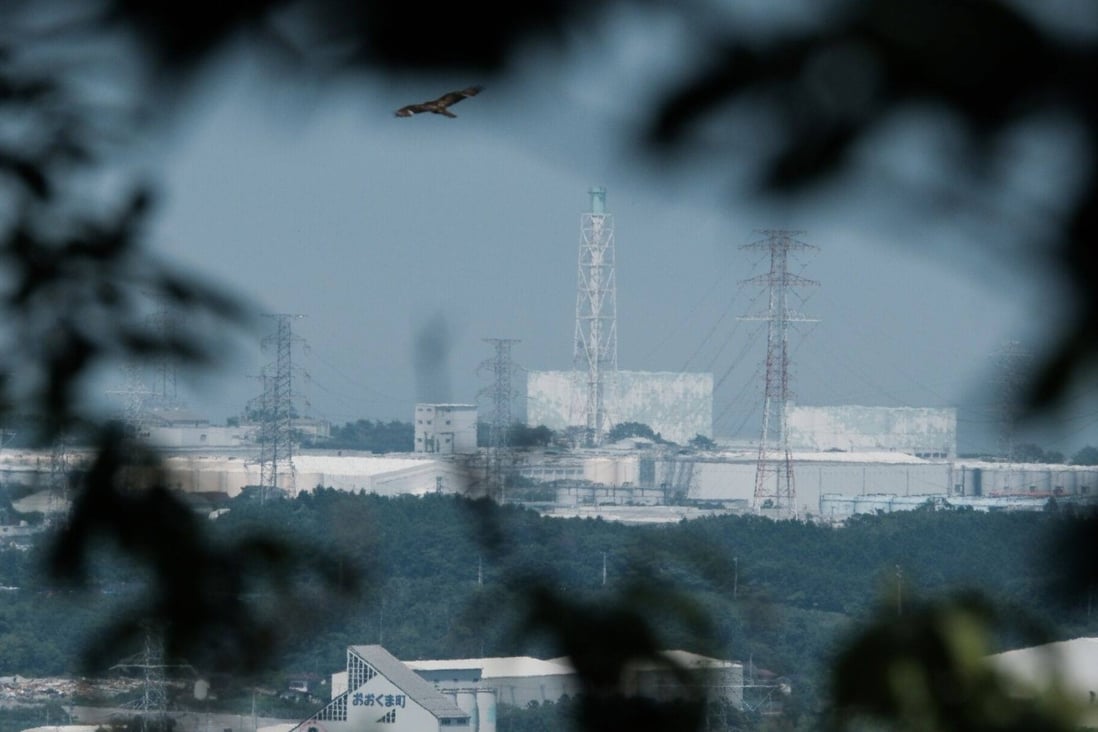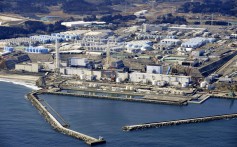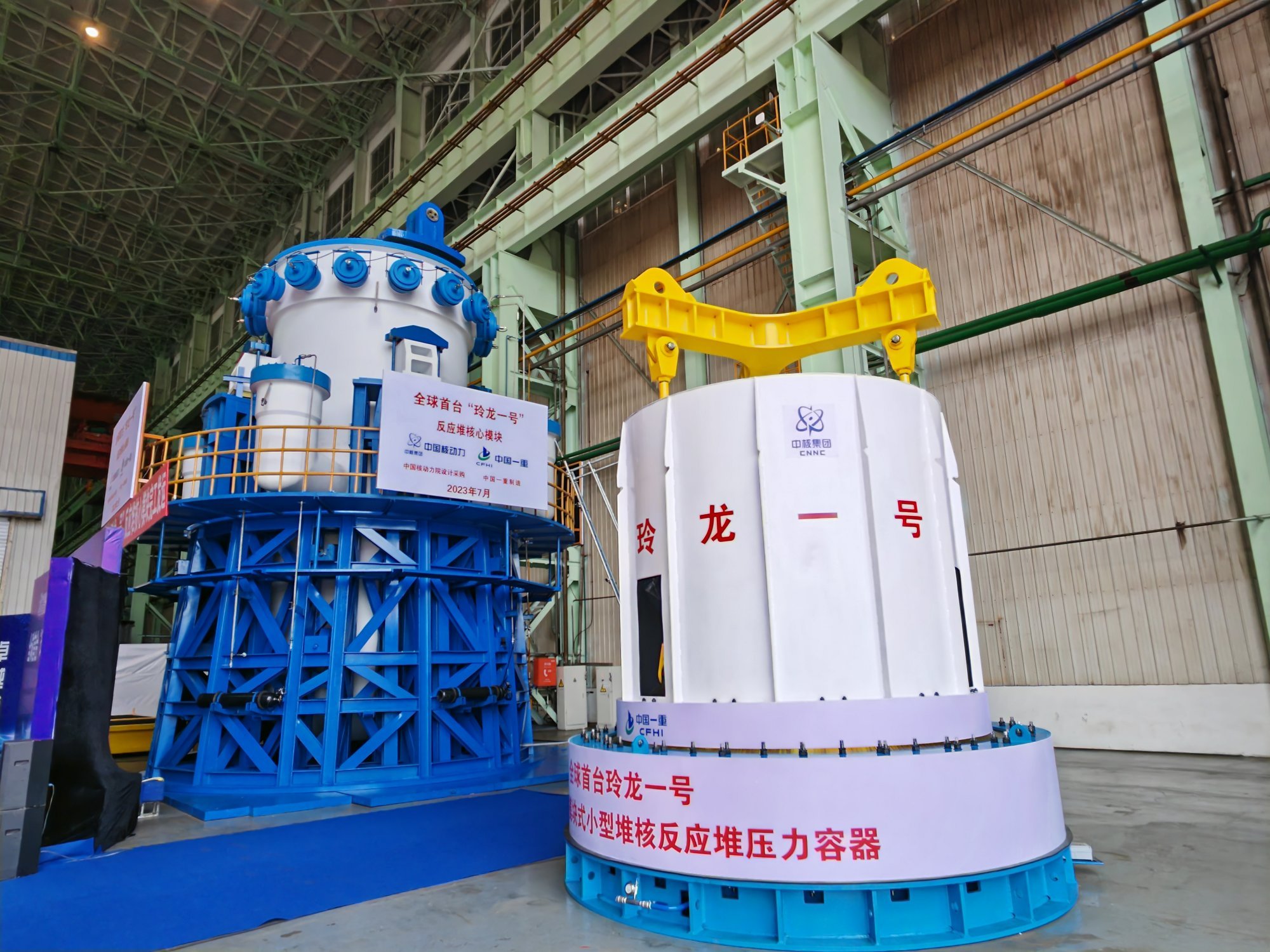China is leading the way, but South Korea, India and Japan are all also on board with the low-carbon energy source’s resurgence
Some call it ‘grasping at straws’ and nuclear certainly has its problems – but new technologies have restored confidence in the sector somewhat
Biman Mukherji
SCMP
6 Aug, 2023

A view of Japan’s crippled Fukushima Dai-ichi nuclear power plant last month. In the years since the disaster, Japanese policymakers have gone from shunning nuclear to embracing it once again. Photo: Bloomberg
Japan’s plan to release treated waste water from the crippled Fukushima nuclear plant may have ignited controversy recently, but more than a decade after the 2011 disaster, the world’s gaze is once again turning to the low-carbon energy source as unprecedented heatwaves underscore Earth’s new ‘era of global boiling’.
In a G20 statement on the energy transition last month, world leaders highlighted the role nuclear energy can play in cutting emissions and providing energy security.
Nuclear plants are also capable of meeting baseload demand – providing the minimum amount of electricity a grid needs – because their power output is much more constant than intermittent sources such as solar or wind.
Climate experts say the prominence given to nuclear power by the G20 text is a sign of its possible resurgence. It’s certainly making a comeback in Asia, where China, South Korea, Japan, and India are leading the way.
6 Aug, 2023

A view of Japan’s crippled Fukushima Dai-ichi nuclear power plant last month. In the years since the disaster, Japanese policymakers have gone from shunning nuclear to embracing it once again. Photo: Bloomberg
Japan’s plan to release treated waste water from the crippled Fukushima nuclear plant may have ignited controversy recently, but more than a decade after the 2011 disaster, the world’s gaze is once again turning to the low-carbon energy source as unprecedented heatwaves underscore Earth’s new ‘era of global boiling’.
In a G20 statement on the energy transition last month, world leaders highlighted the role nuclear energy can play in cutting emissions and providing energy security.
Nuclear plants are also capable of meeting baseload demand – providing the minimum amount of electricity a grid needs – because their power output is much more constant than intermittent sources such as solar or wind.
Climate experts say the prominence given to nuclear power by the G20 text is a sign of its possible resurgence. It’s certainly making a comeback in Asia, where China, South Korea, Japan, and India are leading the way.

A wind farm in China’s Xinjiang province. Domestic experts cite Japan’s lack of space for solar and other renewable energy infrastructure as a reason for refocusing on nuclear power. Photo: Shutterstock
“Japan is like a large Singapore with not so much land,” Tatsuya Terazawa, the chairman of Japan’s Institute of Energy Economics, told a July 26 webinar on Asia’s ‘Road to a Sustainable Energy Future’.
He cited this lack of space for solar panels and other infrastructure as among the “constraints on expanding renewable energy” in the country.
Restarting more of the nuclear plants taken offline in the wake of the 2011 earthquake and tsunami that hit Fukushima could provide a way forward, but fears over atomic power have lingered ever since the disaster – with the Japanese government in 2012 promising to phase out its use entirely by the 2030s.
Policymakers now appear to be changing their tune, however, with Terazawa noting that a spike in global oil prices following third-largest producer Russia’s invasion of Ukraine last year had helped refocus minds on nuclear energy, despite the psychological scars.
Japan could develop new nuclear power plants to boost energy security
24 Aug 2022

“If we are to realise carbon neutrality, if we are to realise energy security, we will have to have at least some significant portion of our energy mix through nuclear,” he said. “We believe that will be applicable to many Asian countries.”
Under a new policy adopted in December, Japan said it will aim to maximise the use of existing reactors and prolong the operating life of ageing ones. The government also pledged to develop next-generation reactors.
“In order for Japan to achieve carbon neutrality by 2050, nuclear power will [have to] contribute 20-22 per cent of its target energy mix in 2030,” said Ada Li, vice-president at financial research company Moody’s Investors Service.
Rebuilding confidence
New technologies such as small modular reactors – which are a fraction of the size and more adaptable than mammoth, traditional reactors – have revived confidence in nuclear energy’s safety, affordability and ability to meet multiple energy demands.
As of 2020, more than 50 per cent of the Asia-Pacific’s nuclear-power generation was done in China, according to International Energy Agency data, with South Korea in second place at just under 25 per cent, followed by India and Japan both with around a 6 per cent share each.
New plants are coming online all the time. China is leading the charge, with construction expected to finish on 23 new reactors over the next seven years, according to the World Nuclear Association. India has eight in the works.
But the effect of plants being decommissioned elsewhere will mean nuclear’s share of the global energy mix won’t surpass the current level of around 10 per cent before 2050, International Atomic Energy Agency projections predict.

A multi-purpose onshore small modular reactor is seen last month in China’s northeastern Liaoning province after undergoing testing . Photo: Xinhua
China, India and Japan are exploring using thorium instead of uranium to power nuclear reactors, as it is much more abundant in the Earth’s crust. But Moody’s Li said extraction costs for the element remain high and there are other challenges in terms of handling the material and its waste.
Still, China’s nuclear-safety regulator issued a 10-year operational permit in June for the nation’s first thorium reactor, built by the Shanghai Institute of Applied Physics of the Chinese Academy of Sciences on the edge of the Gobi desert, while construction is also under way on an onshore small module reactor that’s been touted as a world first.
“China is embarking on the world’s largest nuclear plant building programme and is expected to have the highest capacity globally by 2030,” said Trung Ghi, a partner at consulting firm Arthur D. Little and its head of energy for Southeast Asia.
China aims to double its nuclear capacity by building more than 150 reactors by 2035, and if achieved, it will mean the country would have built “more nuclear reactors than the rest of the world has done in the past 35 years”, Ghi said. The United States currently has the most nuclear capacity in the world.

An interior view of a new nuclear power plant in China’s southeastern Fujian province that went online in 2020. China aims to double its nuclear capacity by 2035. Photo: Xinhua
India is also gearing up for a major expansion of nuclear power, with plans to more than triple its capacity to 22.5 gigawatts from around 7GW currently, mainly through the construction of large plants.
But the importation of new reactors is likely to depend on negotiations surrounding India’s nuclear liability law, which assigns responsibility for compensation in case of an accident, said Kaveri Ashok, a senior associate at the Bengaluru-based Centre for Study of Science Technology and Policy think tank.
New Delhi is currently reviewing a six-decade old law that limits private firms’ involvement in the nuclear sector, Bloomberg reported on Thursday. Private companies can build but not operate plants at present, potentially stifling the development of smaller reactors.
“We will see discussions across other Asian nations in the coming years on nuclear,” energy specialist Ghi said.
We will see discussions across ... Asian nations in the coming years on nuclearTrung Ghi, energy specialist
Power demand is expected to boom in Asia over the coming decades, powered by a growing population and energy-intensive industries, and experts say regional players will need to explore multiple paths to reach net-zero emissions.
Ghi cited Indonesia as an example, where four Danish companies signed a memorandum of understanding with state-owned corporations in May to build a nuclear-powered ammonia plant on the island of Borneo.
Singapore has also identified nuclear energy as a potential alternative power source by 2050, Ghi said. The city state’s Energy Market Authority concluded in a March 2022 report that nuclear energy could supply 10 per cent of the country’s needs.
‘Grasping at straws’?
But opinions remain sharply divided over the use of nuclear energy in the region.
“The quest for new nuclear power plants appears to be grasping at straws – very expensive straws – as a substitute for other, fossil-based thermal power plants,” said Grant Hauber, a US-based strategic energy finance adviser at the global Institute for Energy Economics and Financial Analysis.
“New-build nuclear [power plants] will cost tens of billions of dollars per plant and take the better part of a decade to complete per unit. That is valuable [resources] and time being burnt while the use of higher-intensity carbon fuels continues,” he said.
Coal, gas and nuclear have all historically come with high monetary or environmental costs and countries like Japan would be better off focusing on renewables, Hauber said.
‘It’s not over’: 12 years after the Fukushima Daiichi nuclear power plant disaster
“Japan’s efforts on renewable energy have been greatly lagging. This has happened despite Japan having one of the largest and most consistent renewable resources literally surrounding them: offshore wind,” he said.
As of last year, Japan had 136MW of installed offshore wind capacity – a fraction of the nearly 14GW installed in Britain and 31GW in world leader China, according to the Global Wind Energy Council.
Japan aims to have 10GW installed by 2030 and up to 45GW by 2040 as it wants renewables to provide 36-38 per cent of its electricity mix by the end of that decade, up from around 20 per cent now. The nation is aiming to be carbon-neutral by 2050.
Countries like India and China – which are staring down the barrel of a surge in demand and do not have Japan’s land constraints – would also be better off deploying more renewables, Hauber said, especially as nuclear facilities will not be able to replace the millions of jobs lost as fossil fuel-run plants close.
Russia could blow up Zaporizhzhia plant to halt Ukraine’s forces: Zelensky
9 Jul 2023

Nuclear power produces about the same amount of emissions per unit of electricity as wind and about one-third that of solar, energy expert Ghi said. But the power plants also generate radioactive waste, which is hazardous to human health if not indefinitely and securely stored away.
This waste is best disposed of in deep underground repositories, said Ximena Vasquez-Maignan, a nuclear expert with global law firm White & Case, such as the one Finland has already built to store waste for thousands of years, and the ones France and Sweden are developing.
On the whole, anti-nuclear sentiment appears to have ebbed in the years since the Fukushima disaster, she said – even as Russia’s seizure of the plant in Ukraine’s Zaporizhzhia has again highlighted the risks involved with nuclear power.
“Public perception with regard to nuclear is changing, due to the benefits that nuclear can bring. Waste is an issue that countries will have to deal [with],” Vasquez-Maignan said.
“Nuclear [power] will not divert resources from renewables, as the two types of energies are required in order to face constantly increasing energy needs.”

Biman Mukherji
has more than two decades of reporting and editing experience in Asia, focusing on Indian and Asia business.
No comments:
Post a Comment